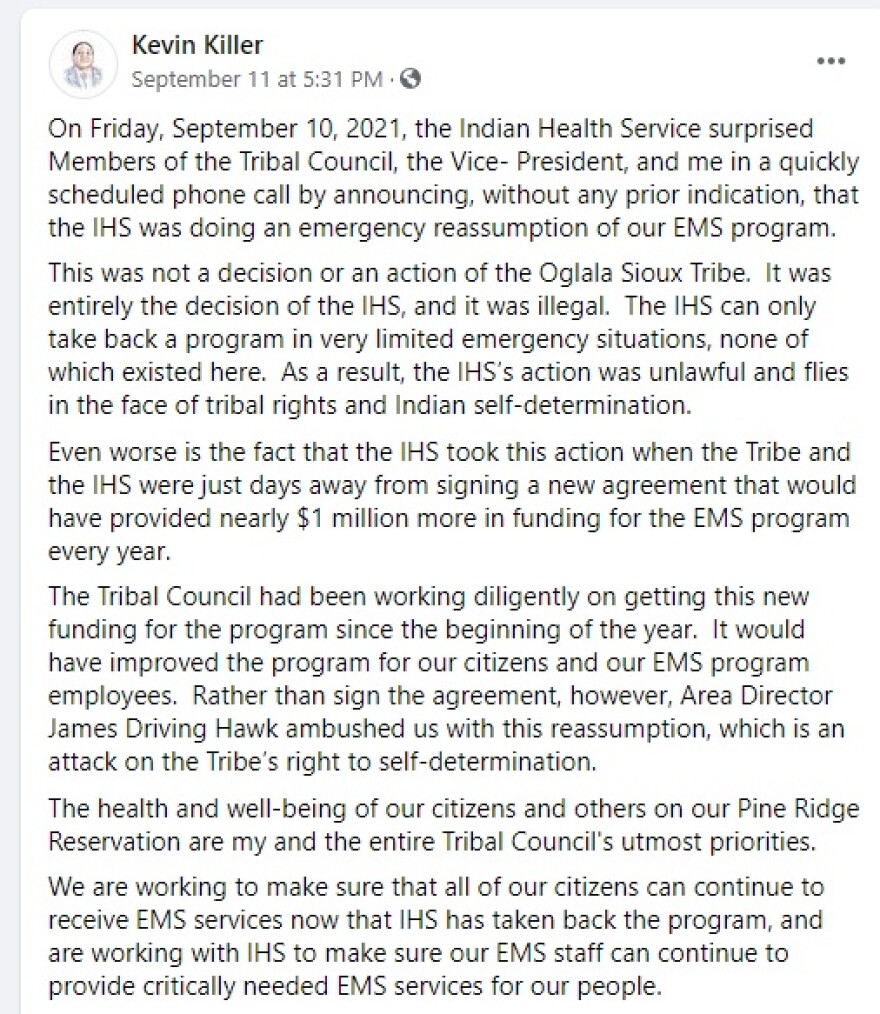Santianna Yellow Horse always knew she wanted to serve her people. The 24-year-old found a way to help by becoming an EMT with the Oglala Sioux Tribe Ambulance Service in March 2020.
“I'm from Pine Ridge, all my family are down there, so that way always my biggest goal with all of my schooling was I wanted to give back to my community,” she said.
But Yellow Horse became frustrated with low staffing and other working conditions that impacted the ambulance service’s ability to help people.
“I just know the people were at a greater risk and it was really hard to see because you come into this job, you want to do the most for everyone,” she said. "For years we've been told by the tribe that change was coming and nothing ever changed.”
The Indian Health Service agrees.
The federal agency initiated an emergency takeover of the ambulance service on Sept. 10. The IHS said it’s increasingly concerned about low staffing that results in slow response times and an inability to transport everyone who calls for help. The IHS said the ambulance service was unable to respond to 172 calls for service in August.
“There is an immediate threat of imminent harm to the safety of” patients and “such threat arises from the failure of the [tribe] to fulfill the requirements of the contract,” the IHS wrote in a letter to President Kevin Killer.
The letter is from James Driving Hawk, the former director of the IHS Great Plains Area Office who recently became CEO of the IHS hospital in Phoenix.
"To date, IHS has been able to cover these lapses without any serious consequences," Driving Hawk wrote. "It is only a matter of time, however, when any given lapse in availability of the tribe's ambulance program will lead to dire results."
The takeover has left ambulance workers and tribal members uncertain about the future of their careers and ambulance provider.
Meanwhile, the tribe is considering legal options after accusing the IHS of an illegal takeover that violates the tribe’s sovereignty.
“There was no notice given to me by Mr. Driving Hawk of his concerns of an imminent threat,” Killer said. “It was definitely an unexpected surprise and it’s forcing us to evaluate our legal options available to us.”
Killer said staffing is a longstanding problem and chronic underfunding of the IHS is to blame. He said he was surprised by the takeover because the tribe and IHS had been discussing solutions.

The ambulance service
The Oglala Sioux Tribe operated its ambulance service through a "638 contract." Such contracts allow tribes, rather than federal agencies, to operate healthcare, education and other programs. The programs are still funded by the federal government.
“It stems partially out of our treaty right because healthcare was a treaty right,” Killer said. “So it’s alarming that you not only have a treaty right being violated, but you also have a 638 agreement being violated because there was no prior notice.”
The ambulance service had five ambulances and about 16 medics when it needed about 40, Yellow Horse said.
The ambulance team serves 40,000 people across 2.4-million acres of the Pine Ridge Reservation, according to Driving Hawk.
Low staffing meant it wasn’t unusual for paramedics and EMTs – whose starting wage was $8.90 – to work 72-hour shifts or more, Yellow Horse said. There were times when only one or two ambulances were staffed at a time, according to her and Driving Hawk.
“Patients were having to wait longer, having to in some instances drive themselves in because there were times that we weren’t able to take anything but emergency traffic,” Yellow Horse said.
When the ambulance service has been unable to answer calls for service, police officers have transported patients or the IHS has paid for costly and medically unnecessary air-ambulance transfers.
Driving Hawk said the IHS spent $800,000 to $1 million on transportation. The money came from funding for "purchased and referred care," known as PRC funding, which is usually meant to reimburse tribal members who need to seek specialty care outside of the IHS system.
The IHS is using four of the tribe’s five ambulances, the agency wrote in an email. Yellow Horse said they are being staffed with temporary crew members from Eagle Butte and Belcourt, North Dakota.
The IHS says on its website that it's hiring ambulance directors, EMTs and paramedics. Salaries for EMTs range from $35,265 to $51,103.
Timeline
Ambulance workers posted a video on Aug. 17 saying they would walk out on Aug. 21 unless they saw serious change from the tribal council.
They made 15 demands focused on raises, time-off and better training and equipment.
Driving Hawk said the IHS worked with the tribe to develop a contingency plan in the case of a walkout. It also sent technical assistance and temporary crews to the reservation.
The workers didn’t walk out because they believed council members were going to take action, Yellow Horse said. The council voted for the IHS to resume control of the ambulance service, but it’s unclear if that was a final decision.
While the walkout was avoided, at least eight workers resigned over the next few weeks, according to Driving Hawk and Yellow Horse.
Yellow Horse said the IHS has been reaching out to her and other ambulance workers, and she’s excited to apply due to higher pay and the chance for improved staffing.
The tribe had not communicated with workers as of Friday morning about the status of their jobs, she said.


